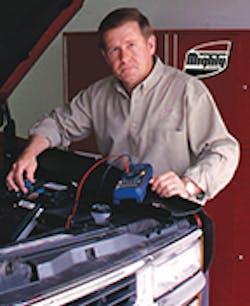Oil filter bypass valves come in many different arrangements. Some are buried out of sight within the oil filter, and others may be mounted in the filter housing or oil filter cap and are clearly visible. For those applications, inspect and replace any damaged components or assemblies, as required. Damaged bypass valves are a major concern and will be covered later in this article. Regardless of the location of the valves, they share the same responsibility and provide protection for the engine in the event of a filter restriction or during periods of high oil pressure or pressure surges. Consider the following key points.
Contamination
The bypass valve is calibrated to open at a given filter restriction or differential pressure. The differential pressure is the difference in fluid pressure between the filter’s inlet and the outlet side of the filter. Once the filter becomes heavily contaminated or restricted, the bypass valve opens, allowing the engine lubricant to continue to flow to the internal engine components. Unfiltered lubricant is better than no lubricant.
Cold Engine/Cold Ambient Temperatures
During cold ambient weather conditions, it is not uncommon for the filter bypass valve to open, allowing lubricant to flow to the vital engine components. When the lubricant warms and the pressure differential across the filter drops below the setting of the bypass valve, the valve closes and filtered oil flows through the system. The bypass valve can also open during periods of high rpm or snap throttle conditions, especially during cold ambient conditions.
A bypass valve stuck in the open position could result in engine damage due to unfiltered lubricant flowing to the bearings, and there would not be any symptoms until it was too late. A valve stuck in the closed position could cause the filter or center tube to collapse when the filter encountered heavy contamination and the valve was unable to relieve the differential pressure. A sticking oil pressure regulating valve in the oil pump can result in the same over pressurization and collapse of the filter and center tube. Often, spin-on filters bulge or split from the excessive pressure created because of a stuck pressure regulating valve.
Chrysler’s 3.6L Pentastar Engine
A high failure rate of broken bypass valves continues to be reported on the Chrysler 3.6L Pentastar engine. Vehicles have been serviced and customers allowed to leave with broken bypass valves and missing springs. Lube service technicians have seen the loose components and heard the springs when they dislodged during a filter change but failed to identify the damaged components as a part of the bypass valve. The bypass valve on the 3.6L Pentastar engine may be positioned in one of two locations:
1. 2011–2013 vehicles will incorporate a bypass valve mounted in the oil filter housing. If the valve is damaged, the complete oil filter housing must be replaced.
2. 2014–2016 vehicles will contain a bypass valve mounted in the oil filter cap. When removing the oil filter from the cap, pull the filter straight from the cap. Do not rock the filter back and forth to release it from the cap, as damage to the bypass valve can occur, requiring a cap replacement.
It is imperative the vehicle does not leave the service facility with a damaged or non-functional bypass valve, as engine damage can result.
Extended Service Intervals
Vehicle manufacturers are promoting extended service intervals, as it helps sell vehicles. With today’s powertrain technology, synthetic lubricants can last 12,000-15,000 miles. Conventional oil filters are not designed to provide protection for that length of service. Vehicles driven for those service intervals should be equipped with an extended life oil filter. Operating a vehicle under an extended service interval with a conventional oil filter is playing Russian roulette with the engine. A lot of attention is given to the lubricant with little consideration as to how long the filter will last without bypassing.
Will your filter provide protection for the engine during an extended service interval? You may not know until it’s too late to save the engine from extensive damage.
About the Author

